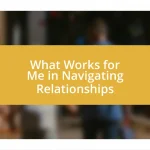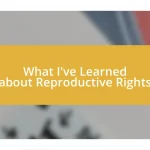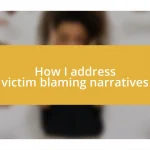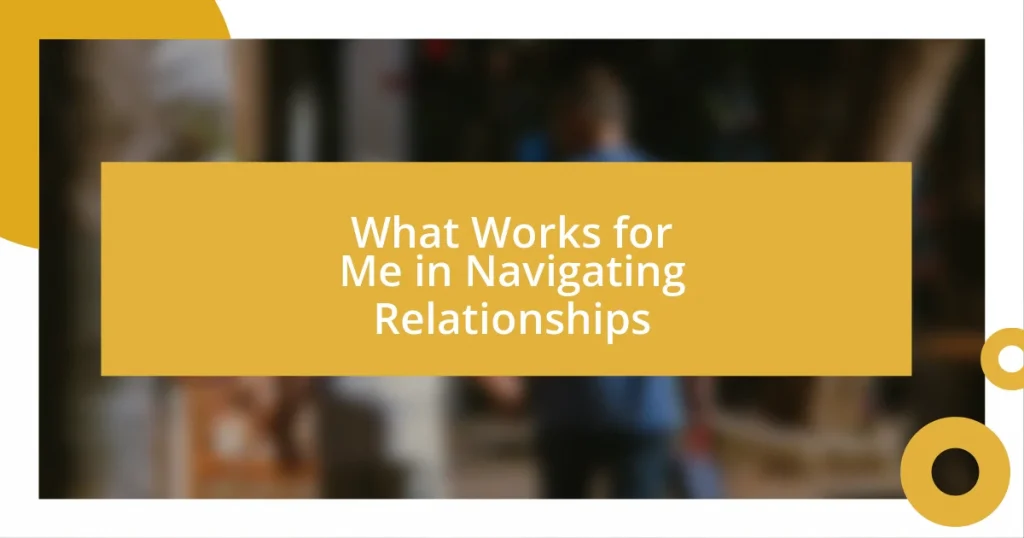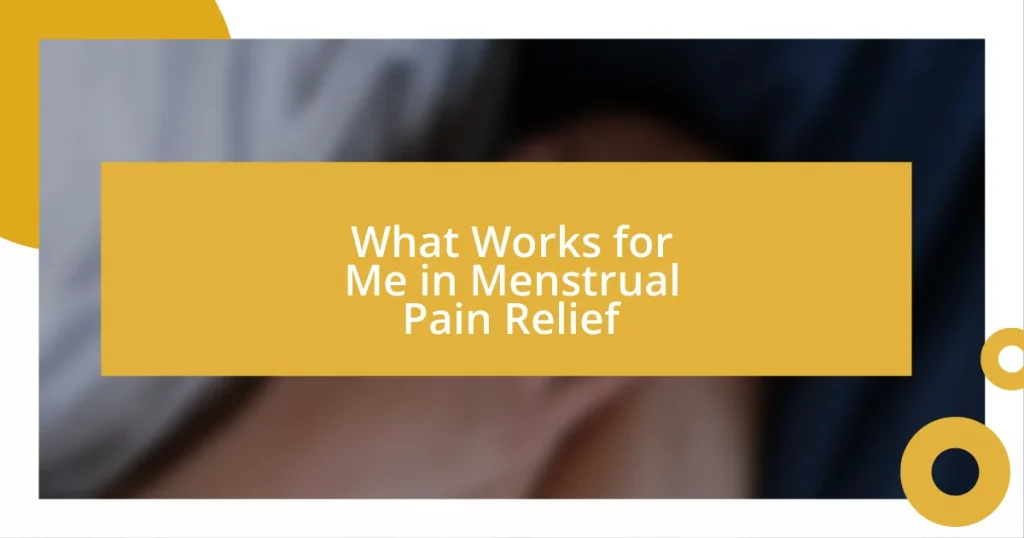Key takeaways:
- Advocacy for survivors emphasizes creating safe spaces and fostering connections, which can empower individuals and reshape community perceptions.
- Developing a personal advocacy plan allows individuals to set actionable goals, identify resources, and engage with others to enhance their advocacy efforts.
- Sharing stories and engaging in community discussions can amplify survivor voices, foster understanding, and inspire collective healing and empowerment.

Understanding survivor advocacy
Survivor advocacy is about elevating the voices of those who have experienced trauma and ensuring they are heard and respected. I remember one particular moment when a fellow survivor shared their story at a community event; the silence in the room was palpable. It was then I realized how powerful sharing our narratives can be—it not only helps us heal but also empowers others to take that brave step forward.
When I think about advocacy, it strikes me how crucial it is to create safe spaces for survivors. I still can’t shake the memory of attending a support group for the first time. The warmth and understanding from others who truly grasped my pain was something I had never encountered before. It made me wonder—how can we replicate that atmosphere in wider communities? Genuine connection can break barriers and build the trust necessary for meaningful advocacy.
Moreover, effective survivor advocacy must address systemic issues that perpetuate harm. I often ponder on the question of how many potential allies walk past survivors every day without recognizing their struggles. I’ve seen firsthand how advocacy can reshape not just individual lives but entire communities when we actively engage in education and raise awareness. Each conversation has the potential to create ripples, shaping perceptions and fostering empathy.

Developing a personal advocacy plan
Creating a personal advocacy plan is like drawing a map for your journey as a survivor and advocate. It allows you to pinpoint your strengths, identify the challenges you want to address, and set actionable goals. I recall sitting down one afternoon with a notebook, pouring out my thoughts on what mattered most to me. It was empowering to witness my own feelings and aspirations morph into a tangible plan, something that felt solid rather than abstract.
As I worked through my plan, I found it helpful to break down the steps. Here’s what I suggest including:
- Self-Reflection: Consider your own experiences and values. What drives you?
- Goal Setting: Define specific, measurable objectives. What changes do you want to see?
- Identify Resources: Look for support networks and organizations. Who can help you along the way?
- Education and Awareness: Determine how you will educate yourself and others on the issues.
- Engagement Strategies: Plan how to connect with and empower others. What methods feel authentic for you?
- Evaluation: Regularly revisit your plan. What’s working, and what needs adjustment?
Involving others in this process brings a new dimension to advocacy. I once partnered with a friend who shared a similar passion. When we combined our vision and experiences, the energy shifted, and it turned into something greater than ourselves. That collaborative spirit became a motivation to keep pushing forward, reminding me why we tell our stories.

Building connections with local organizations
Building connections with local organizations is essential to creating a strong support network for survivors. I vividly remember when I first reached out to a local organization that focused on trauma recovery. It felt daunting, but once I made that initial connection, I found a community of supportive advocates who were eager to share resources and ideas. Each organization has its unique strengths; some offer counseling services, while others focus on community outreach, so exploring these options can broaden our impact.
In my experience, attending local meetings can open unforeseen doors. I recall joining a workshop held by a nonprofit dedicated to mental health awareness. It was there I met professionals and fellow survivors who inspired me. Our shared stories transformed those meetings into brainstorming sessions filled with compassion and understanding. It’s rewarding to forge relationships that amplify our voices through collaboration—each partnership enhances our advocacy efforts.
Finally, maintaining these connections requires intentional effort. I often remind myself to check in on my contacts, whether that means sending a quick email or attending events. These small gestures matter and create a ripple effect of support within our local survivor community. The more we engage with organizations, the more resources and support we can marshal for those who need it most.
| Organization Type | Examples |
|---|---|
| Counseling Services | Local therapy centers, Hotlines |
| Community Outreach | Advocacy groups, Nonprofits |
| Educational Programs | Workshops, Seminars |

Sharing stories to raise awareness
Sharing stories is one of the most powerful ways I advocate for survivors like me. I think back to a time when I bravely shared my own experience in a community forum. The response was overwhelming—messages flooded in from others who felt compelled to share their journeys too. It became a domino effect; weaving our stories together created a tapestry of understanding, strength, and resilience that resonated deeply within our community.
I often wonder how many lives could be touched through storytelling. Each story has its unique shape, yet they all reflect common threads of struggle and triumph. I remember listening to a fellow survivor share her harrowing tale of recovery, and I could feel the room’s collective breath as she detailed her journey. That moment illuminated a simple truth for me: when we reveal our vulnerabilities, we not only empower ourselves but also offer hope to others grappling with their realities.
It’s fascinating to see the ripple effect of shared stories. I attended a workshop focused on survivor narratives, where participants exchanged their experiences. This wasn’t just a sharing session; it turned into a catalyst for new initiatives. Inspired by the courage of those around me, I began organizing local storytelling events to encourage more survivors to step into the spotlight. The emotional release and collective healing that unfolded at those gatherings served as a poignant reminder of the importance of using our voices to both raise awareness and foster a supportive environment.
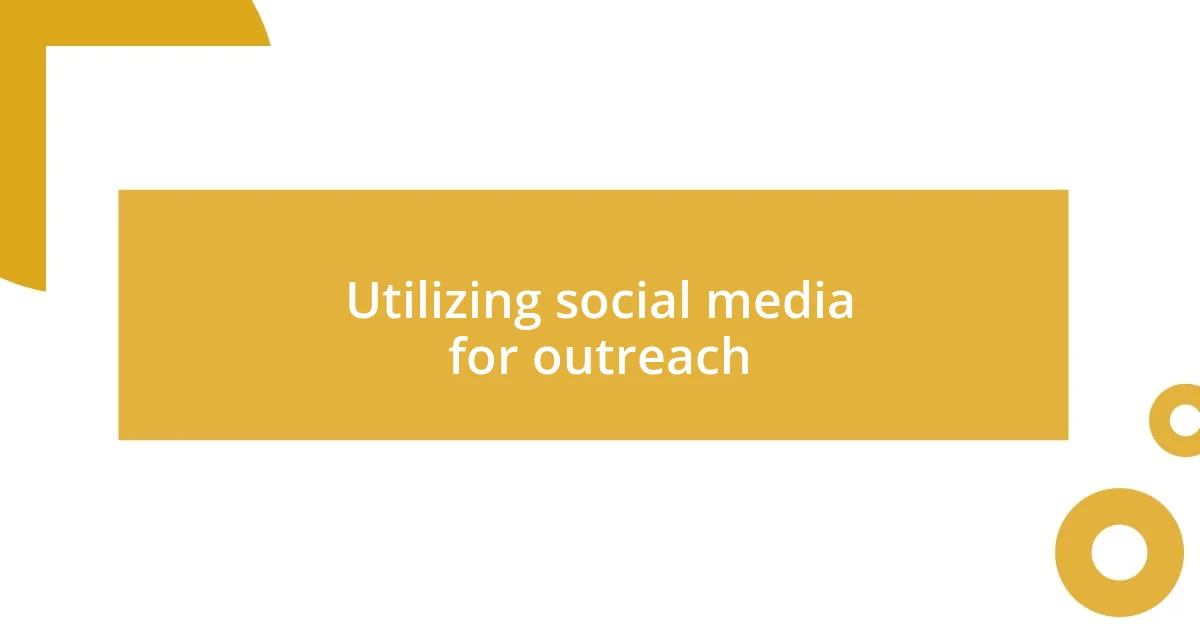
Utilizing social media for outreach
Using social media for outreach can feel like an immense opportunity. I distinctly remember when I created my first Instagram account dedicated to supporting survivors. I felt a mix of excitement and fear—would people actually engage? But to my surprise, the interactions flowed. People started sharing their stories in the comments, and before I knew it, my little corner of the internet became a safe space where vulnerability thrived.
Social media platforms allow us to reach wider audiences and connect with individuals who might otherwise feel isolated. I regularly use Facebook Live sessions to discuss healing strategies and share resources. One evening, I hosted a Q&A session, not knowing how many would tune in. As the comments poured in, I realized how essential it is to foster these conversations—we need spaces to ask questions, seek support, and share triumphs. That’s when I understood: social media isn’t just a tool; it’s a lifeline.
Thinking back, there was a time I joined a Twitter chat focused on survivor advocacy. The energy was palpable, and the camaraderie felt real. I found not just followers, but allies who champion our cause. Each retweet and sharing of powerful stories reinforces the notion that we are not alone. Isn’t it inspiring to realize that a simple tweet can ignite conversations and encourage others to join our movement? It’s a reminder that our voices, amplified online, can lead to meaningful connections and real change.

Engaging in community discussions
Engaging in community discussions is crucial for elevating the voices of survivors. One evening, I took part in a local town hall where survivors were invited to share their experiences. As I sat in the audience, listening to stories of resilience and survival, I felt a wave of emotions rush over me. It reminded me of the community’s strength—each voice added to a collective narrative that held the power to challenge societal norms and stigmas surrounding trauma.
I’ve found that proactive engagement, like participating in panel discussions or workshops, can spark meaningful conversations. During one panel, I shared my journey, but what resonated the most was the ensuing dialogue. People began asking questions and sharing their insights, which created a safe atmosphere. It struck me how vulnerability can breed connection; when we engage openly, we create a foundation for empathy and understanding. Have you ever noticed how a simple question can unlock a wealth of shared experiences? That realization hit me hard, and I left feeling energized to continue these discussions.
In my experience, online community forums have also proven invaluable. There was a time when I joined a discussion group for survivors, and I quickly realized how transformative these dialogues could be. We could express our feelings without the fear of judgment; it was like finding a home for our stories. Watching others connect and validate each other’s experiences deepened my belief in community as a healing space. It’s fascinating to think—what if more survivors engaged in such discussions? The impact could be profound, encouraging others to find their voices while fostering a supportive community that understands the journey.
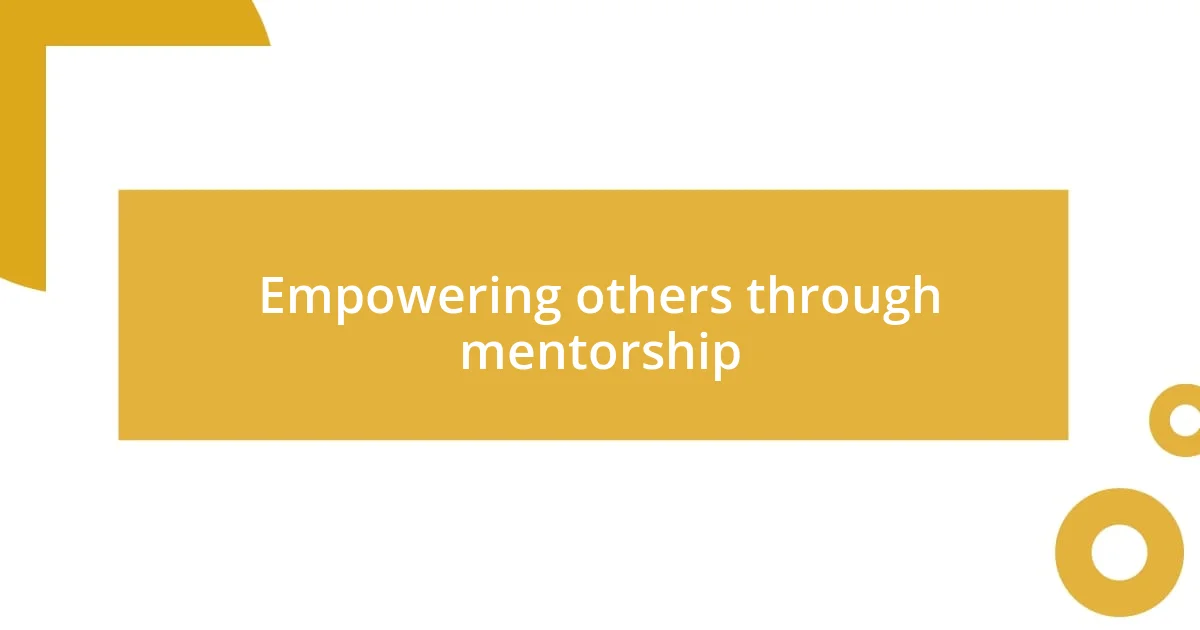
Empowering others through mentorship
Mentorship holds an incredible power in the healing journey for survivors. When I first stepped into a mentor role, I remember how nervous I felt. Would my experiences resonate with someone seeking support? Surprisingly, my first mentee opened up about her struggles right away, and in that moment, I realized the profound influence mentorship has. It creates a safe corridor of connection where we can share our stories, wisdom, and ultimately, our strength.
Watching others grow through mentorship is both humbling and rewarding. I recall guiding a young woman who faced daunting challenges after her trauma. As she began to reclaim her voice, I was struck by her resilience—it reminded me of my own journey. We navigated through discussions on boundaries, self-care, and empowerment. Can you imagine how uplifting it is to witness someone blossom from uncertainty into confidence? It’s a vivid reminder that our shared experiences have the potential to uplift others and inspire courage where it’s needed the most.
Each mentoring relationship is unique, offering the chance to foster mutual growth. I still cherish my time with a mentee who, after numerous sessions, found the courage to advocate for policy changes in her community. I often wonder how many lives her bravery will touch. For me, it’s a testament to the idea that mentorship isn’t just about giving guidance; it’s about cultivating an environment where both parties can learn from each other and transform together. Isn’t that what we all seek—a connection that empowers, uplifts, and brings us closer to our true selves?
